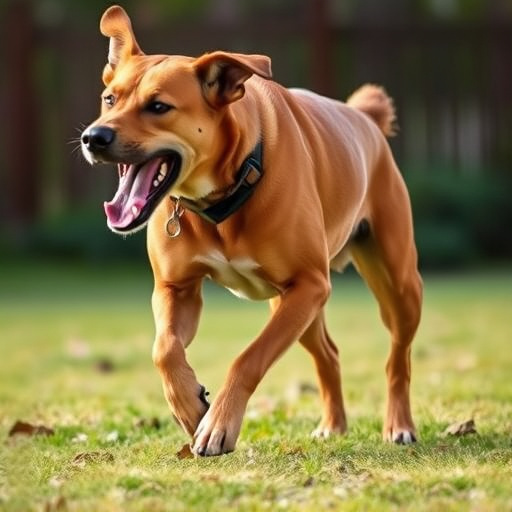Dog pepper spray exposure can cause severe health issues due to capsaicin's irritant effects, leading to symptoms like excessive panting, drooling, and breathing difficulties. Prompt treatment involves rinsing affected areas with water for 15-30 minutes and seeking immediate veterinary care. Even mild reactions require professional assessment for potential treatments like antihistamines or eye drops. Prevent future aggressive encounters by identifying triggers, implementing positive reinforcement training, establishing routines, and ensuring proper exercise and mental stimulation.
“Protecting your safety and that of others around aggressive dogs is paramount. This comprehensive guide delves into the intricacies of dog pepper spray exposure, equipping you with essential knowledge on how to recognize symptoms, understand its composition, and manage potential risks. Learn effective first aid steps for treating exposed dogs and explore preventive strategies to keep future incidents at bay. Discover the ins and outs of managing aggressive canine behavior, especially regarding pepper spray exposure, with our expert advice on How to Treat Dog Pepper Spray Exposure.”
- Understanding Dog Pepper Spray Exposure: Symptoms and Risks
- What is Pepper Spray for Dogs? Composition and Effects
- Treating and Managing Dog Pepper Spray Exposure: First Aid Steps
- Preventing Future Incidents: Strategies to Keep Your Dog Safe
Understanding Dog Pepper Spray Exposure: Symptoms and Risks
Dog pepper spray exposure can be a serious matter, as it involves the potentially harmful effects of capsaicin, the active ingredient in pepper spray. When a dog is exposed, whether through direct contact or inhalation, symptoms may include excessive panting, drooling, and irritability. In more severe cases, affected dogs might experience difficulty breathing, nausea, vomiting, and even temporary blindness.
Understanding these risks is crucial when it comes to knowing how to treat dog pepper spray exposure. Prompt action is essential; if left untreated, complications can arise, especially in sensitive or elderly dogs. Treatment involves supportive care, such as rinsing the eyes and affected areas with copious amounts of water, and seeking veterinary attention immediately. Medications may be required to manage pain, inflammation, and any respiratory issues. How to treat dog pepper spray exposure effectively is a vital skill for pet owners and caregivers, ensuring their canine companions receive prompt and adequate care in these situations.
What is Pepper Spray for Dogs? Composition and Effects
Pepper spray for dogs is a specialized non-lethal self-defense tool designed to temporarily incapacitate aggressive canines. It’s a liquid aerosol that contains capsaicin, the active ingredient found in chili peppers, mixed with other chemicals to enhance its effectiveness and duration. When deployed, pepper spray irritates a dog’s eyes, nose, and throat, leading to temporary blindness, coughing, and difficulty breathing. This disruption causes the dog to become disoriented and often less aggressive, providing an opportunity for safe escape or intervention.
The composition of dog pepper spray varies among brands but generally includes capsaicin, a solvent like ethanol or isopropyl alcohol, and sometimes additional agents to enhance penetration or reduce odour. The effects typically last between 15 to 30 minutes, during which time the dog must remain in a calm state to prevent further irritation and potential injury. How to Treat Dog Pepper Spray Exposure involves immediate thorough washing of the affected areas with warm water and soap to remove any residual spray, along with seeking veterinary care if severe reactions occur.
Treating and Managing Dog Pepper Spray Exposure: First Aid Steps
In the event that your dog is exposed to pepper spray, it’s crucial to act swiftly and administer appropriate first aid. The initial step is to remove the dog from the area where the exposure occurred as quickly as possible. Pepper spray can cause severe irritation and discomfort in dogs, leading to coughing, sneezing, and difficulty breathing. If possible, take the dog to a well-ventilated space or outside to help dissipate the effects of the spray.
Next, thoroughly rinse the affected areas with plenty of water for at least 15 minutes. This includes washing the eyes, nose, mouth, and any skin where the spray made contact. Be sure to seek veterinary attention promptly, even if the symptoms appear mild. A veterinarian can assess the severity of exposure and provide necessary treatment, such as antihistamines or eye drops, to alleviate discomfort and prevent potential long-term damage. Remember, how to treat dog pepper spray exposure involves quick action, thorough rinsing, and professional veterinary care.
Preventing Future Incidents: Strategies to Keep Your Dog Safe
If your dog has had an aggressive encounter, it’s crucial to understand how to prevent future incidents. The first step is understanding what triggered the aggression and addressing those underlying issues. This might involve seeking professional help from a dog trainer or behaviorist who can provide tailored strategies. Regular training sessions focused on obedience and positive reinforcement can significantly reduce aggression.
Additionally, establishing clear boundaries and consistent routines can help your dog feel secure. Ensure proper exercise and mental stimulation through daily walks, playtime, and interactive toys. How to Treat Dog Pepper Spray Exposure should also be a consideration if your dog comes into contact with pepper spray during an incident. Rinse the affected areas thoroughly with water, seek immediate veterinary care, and follow professional guidance for decontamination to ensure your dog’s safety and well-being.
Pepper spray for aggressive dogs can be a controversial topic, but understanding its proper use and the subsequent treatment of exposure is crucial. By recognizing the symptoms and risks associated with dog pepper spray exposure, and implementing effective first aid steps, owners can ensure their pet’s safety and well-being. Preventative strategies, such as positive reinforcement training and secure fencing, are essential to avoid future incidents. Knowing How to Treat Dog Pepper Spray Exposure involves staying informed about the composition of these products and taking prompt action if your dog is affected.
